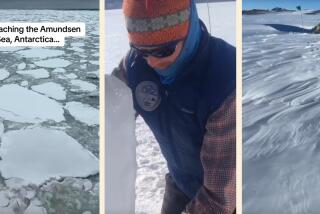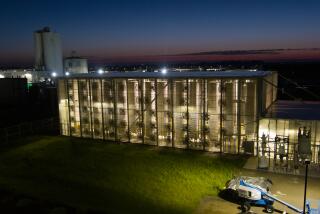A Researcher Who Keeps His Mind on the Clouds : Richard Turco, a Co-Author of ‘Nuclear Winter’ Theory, Continues Studies of Effects of Atomic Warfare
- Share via
Although at first glance they may seem strange, the poster-size photographs of nuclear explosions on the living room wall in Richard Turco’s Pacific Palisades home are not really inappropriate.
After all, as a research scientist at R & D Associates--a Marina del Rey-based think tank with numerous Defense Department contracts--Turco has studied nuclear weapons and their effects for much of the last 15 years.
Yet a closer look at the photos reveals something more. One of them is adorned with peace buttons, and below the billowing mushroom cloud is inscribed a line from Act I of Shakespeare’s “Henry VIII”: “Heat not a furnace for your foe so hot that it do singe yourself.”
No Peace Activist
Turco is not a peace activist. He does not march in demonstrations or carry picket signs. But he is, along with four fellow scientists including Cornell University astronomer Carl Sagan, the co-author of the controversial theory of “nuclear winter,” which has irrevocably altered the international discussion of nuclear war strategy.
The theory--first formally proposed in a December, 1983, article in Science magazine--predicts that so much smoke and dust would be generated during a nuclear war that it might block out most of the sun’s light for weeks or months, sending temperatures at the Earth’s surface plummeting to as low as minus 13 degrees Fahrenheit. And according to a companion study performed by Stanford University biologist Paul Ehrlich, Harvard University biologist Stephen J. Gould, Sagan, and others, a nuclear winter could lead to the extinction of many of the Earth’s animal species, including the human race.
This past July, in recognition of his work as the lead scientist on the nuclear winter theory, Turco was one of 25 Americans to win the MacArthur Foundation’s so-called “genius grant.” The amount of money awarded depends on the age of the recipient, and Turco, at 43, can expect to get $216,000 paid out over the next five years--no strings attached.
Last year, Turco and six colleagues received the prestigious Leo Szilard Award, which is presented by the American Physical Society for physics research in the public interest. Yet despite his recent public recognition, all the attention does not seem to have gone to his head.
‘A Lot of Prima Donnas’
“There are a lot of prima donnas in the science world,” said Brian Toon, a research scientist at the NASA Ames Research Center in the San Francisco Bay Area and one of Turco’s co-authors on the nuclear winter paper. “You see a lot of aggressive people who would stab you in the back. But Rich is a very low-key person, very unassuming, and very generous to other people. He goes out of his way to give credit to other people where it’s due.”
Similar sentiments are voiced by Cornell’s Sagan. “What was clear to me the first couple of times I met him,” Sagan said, “was what a firm grasp of the fundamentals of the subject matter he had. And what a modest, unassuming, friendly person he was. That mix is very rare.”
An explanation might be found in Turco’s origins. His grandparents came to the United States from Italy, and his parents grew up in the ghettos of New York City.
When he was about 5, his family moved to Fair Lawn, a small town in northern New Jersey. “We really went there to escape New York City,” Turco said. His parents had “lived in some pretty raunchy neighborhoods in New York, and it was a big breakthrough for them to get out to Jersey, to the country.”
Turco soon began to show an aptitude for science. “When I was a kid I liked to take things apart and put them together,” he said. “I was always getting my parents upset by disassembling radios and things of that sort. I had piles of junk all over.”
After high school, Turco enrolled at New Jersey’s Rutgers University and majored in electrical engineering. “I did very well the first semester. Then I joined a fraternity and I took a nose-dive, my grades did anyway.”
He dropped out of school for a year and went to work at the Ford Motor Co.’s Rahway assembly plant, where he “got to appreciate hard work, and went back to school the next year.”
Upon receiving his bachelor’s degree, Turco went on to the electrical engineering department at the University of Illinois’ Urbana campus, where he received his doctorate in 1971. His thesis adviser, professor of electrical and computer engineering Chalmers Sechrist, remembers “very vividly that he was an excellent student. He was always looking for creative solutions to problems. I’m not at all surprised that he has reached this level of achievement.”
It was while at the University of Illinois that Turco first became interested in the science of the earth’s atmosphere, called aeronomy. He explains that in the early days of the field, aeronomers spent a lot of time bouncing radio signals off the Earth’s ionosphere to study the upper atmosphere. Thus there were always a lot of electrical engineers around to build the required equipment, and when a graduate assistant position opened, Turco got the job.
“I have to admit that when I first got involved in this field of aeronomy, I thought it was a little hokey,” Turco said. “It wasn’t as elegant as physics. But then at the same time, it was new territory, and it looked like there were a lot of opportunities.”
After receiving his degree, Turco moved to California with his wife Barbara, whom he met at the University of Illinois, and their son, Richard, and took a research position at the NASA Ames Research Center. Turco soon became involved in scientific collaborations with other aeronomers, and with a colleague devised one of the first mathematical models for the stratospheric ozone layer. Later in 1971 he moved on to R & D Associates in Marina del Rey, where he was worked ever since.
Interest on Climate
Out of his work on the stratospheric ozone layer, Turco became interested in the behavior of small particles in the atmosphere and their effect on climate. With his collaborators--who have often included colleagues at Ames--he has studied volcanic clouds, including those formed by the eruption of Mt. St. Helens in May, 1980, the clouds of Venus, the haze on Titan, which is the largest moon of Saturn, and the 1908 explosion in Tunguska, Siberia, which some scientists believe was caused by a meteor. Then, in 1980, physicist and Nobel laureate Luis Alvarez and his son, geologist Walter Alvarez, proposed a controversial theory that the extinction of dinosaurs had been due to a large asteroid striking the Earth and raising clouds of dust that covered the entire planet, blocking out sunlight.
Turco and his co-workers began developing mathematical models for this hypothetical event, and in late 1981 Brian Toon presented a paper on their work at a meeting of the U.S. Geological Society in Snowbird, Utah.
A couple of scientists from the National Academy of Sciences were at the meeting and asked Toon about dust clouds from nuclear explosions. Toon said he would look into it, and he and Turco did some preliminary calculations, which, Turco said, “looked pretty interesting.”
Soon afterward, two scientists working in Colorado, Paul Crutzen and John Birks, wrote an article for the Swedish journal Ambio on the effects of nuclear war on the ozone layer. They found that although the ozone layer would not be seriously affected, the smoke from fires caused by nuclear bombs might be very significant.
When Turco and Toon learned of this paper, they began taking a closer look at the problem. “What we first saw when we started doing these calculations, very surprisingly, the surface temperature dropped by tens of degrees when we put a lot of this black soot in the atmosphere,” Turco said.
“This was sort of counter-intuitive, and we thought it was at first very strange. If you put black stuff in the atmosphere you would expect the atmosphere to absorb more solar radiation and get hotter, not colder.
“Well, indeed, what was happening was that the atmosphere, where the smoke was being absorbed, was getting hotter, but the ground below was getting very cold indeed. What we had produced was a tremendous temperature inversion in the atmosphere. It was like lowering the stratosphere down very close to the surface.”
Turco and Toon were joined in the work by NASA Ames scientists Thomas Ackerman and James Pollack, and also by Carl Sagan, with whom Toon and Pollack had worked as graduate students. After the publication of the Science article in December, 1983, the researchers became known in scientific circles as the TTAPS group, after the first initial of each of their last names.
The publication of the nuclear winter theory has led to considerable controversy between proponents of nuclear disarmament and advocates of a strong national defense. But at first, Turco tried to steer clear of all this.
“Early on, certainly, myself and my colleagues--except for Carl--simply avoided any discussions or forums where the main issues had to do with policy implications. We were absolutely concerned with maintaining credibility and being able to continue our work in that atmosphere that you have to have. Once you begin to politicize an issue, your colleagues begin to question your veracity.”
But more recently, as the implications of the theory have become more clear, Turco says he has begun to change his views somewhat. “My work at R & D Associates has always been associated with looking at the effects of nuclear weapons. I was usually concerned with the effects of one bomb. Then you begin to get the big picture, and it looks pretty grim. Now it becomes depressing, it becomes overwhelming. And so I went from being, I guess you might say, technically indifferent, to being highly concerned.”
Policy Questions
Turco and some of his co-workers are now working on a paper on the policy questions, in part to answer some of the criticisms that have been leveled at the nuclear winter theory. And in the meantime, he is continuing with his research, which the MacArthur Foundation grant will help pay for.
A major upcoming project is an experimental fire, which will be staged before the end of this year in the Angeles National Forest. Turco and other scientists will be gathering data from the fire to see if some of the predictions of the theory hold up.
He also may use some of the MacArthur money to take sabbaticals. “I can do whatever I want with it, including buying fancy cars, buying a Ferrari or something. Which I probably won’t do. You see my car out front”--he gestured toward a beat-up 1971 Chevrolet parked in front of his home--”It still runs well. It may look a little banged up, but it’s almost a classic.”






